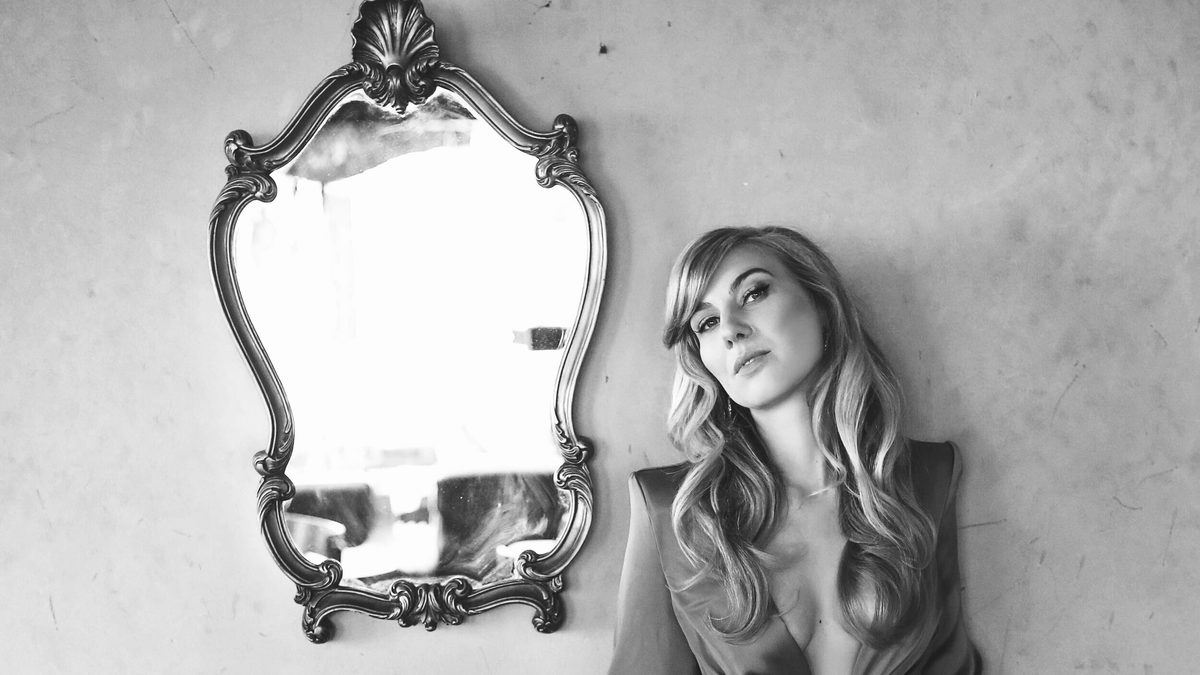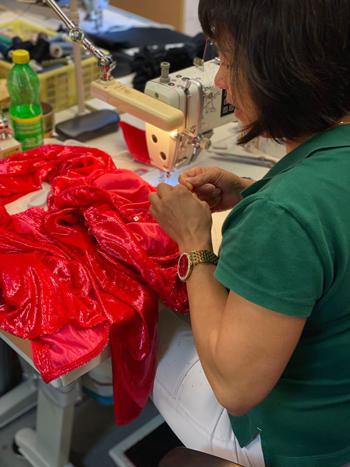
She Represents
14 October 2023, 2:30pm - 3:30pm
Please click here to download the Texts & Translations, and to view the paintings for this event.
Scroll down to read Rowan Hellier’s programme note.
What to expect Inspired by 1920s-30s art of the ‘New Objectivity’ movement in Germany, She Represents (the title of a 1928 watercolour by Jeanne Mammen) is a costumed lieder recital exploring female expression and definition of self. Compositions by Rita Strohl, Kurt Weill, Cathy Berberian and others are augmented by costumes based on artworks by Mammen and Otto Dix, including a dress created by renowned German-Chilean stage and costume designer Rebekka Dornhege Reyes.
The Artists The Guardian wrote that Rowan Hellier’s 2021 Festival recital ‘captivated… with wit, aplomb and a consistently velvety tone’. The acclaimed American pianist Jonathan Ware has ‘a clear sense of dramatic purpose’ and ‘unrivalled keyboard finesse’ (Musical America Worldwide).
Rehearsal footage
Sketch for costume design by Rebekka Dornhege Reyes

Costume preparation

Programme
- Francis Poulenc (1899 - 1963)
- Voyage à Paris (1940) FP 107 no.4 from Banalités
- Hôtel (1940) FP 107 no.2 from Banalités
- Rita Strohl (1865 - 1941)
- 5. La chevelure from Douze chants de Bilitis
- 9. Bilitis from Douze chants de Bilitis
- Cathy Berberian (1925 - 1983)
- Stripsody
- Kurt Weill (1900 - 1950)
- Seeräuber-Jenny from Die Dreigroschenoper (Three Penny Opera)
- Vom ertrunkenen Mädchen from Das Berliner Requiem
- Mischa Spoliansky (1898 - 1985)
- Morphium (piano solo)
- Maskulinum Femininum
- Arnold Schoenberg (1874 - 1951)
- Der genügsame Liebhaber (1901) from Brettl-Lieder (Cabaret Songs)
- Arie aus dem Spiegel von Arcadien / Seit ich so viele Weiber sah / Langsamer Walzer (1901) from Brettl-Lieder (Cabaret Songs)
- Francis Poulenc (1899 - 1963)
- Sanglots (1940) FP 107 no.5 from Banalités
- Kurt Weill (1900 - 1950)
- Buddy on the Night Shift
- Complainte de la Seine from Trois Chansons
- Nannas Lied (1929)
- Mischa Spoliansky (1898 - 1985)
- Ich bin ein Vamp
Notes on the Programme
Inspired by 1920s-30s art of the ‘New Objectivity’ movement in Germany,
She Represents (the title of a 1928 watercolour by Jeanne Mammen) is a costumed lieder recital exploring female expression and definition of self. Compositions by Rita Strohl, Kurt Weill, Cathy Berberian and others are augmented by costumes based on artworks by Mammen and Otto Dix. The final dress is created by renowned German-Chilean stage and costume designer Rebekka Dornhege Reyes.
The recital centres on the 'New Woman' - a feminist ideal and icon of changing gender norms that arose late in the 19th century and had far-reaching influence well into the 20th. Mammen and Dix were both fascinated, immortalising her in their portraits of real-life Berliner performers, barflies and thinkers. It's interesting to note the differences in Dix's and Mammen’s depictions of these women: Mammen's portraits have an intimate closeness, whilst Dix’s portrayals of dancer Anita Berber and journalist Sylvia von Harden convey widely shared prejudices, prejudices from which Mammen and other female painters depicting women of this same period radically distanced themselves.
At a time of unprecedented freedoms in the post-First World War Weimar era, these new women played with gender identity and performance, female sexuality and corporeal agency, along with pre-existing clichéd myths, stereotypes and archetypic forms such as the femme fatale, which were often projected onto them by the male gaze. In so doing they challenged existing power structures and forged real progress in the fields of feminism, civil rights and queer liberation. I use these archetypic and stereotypic forms as section titles as a means of exploring, challenging and unpicking these myths of femininity, and am of course not endorsing their use in the reduction of women to stereotypes or objects of male fantasy. An important female archetype missing here is the old or older woman; there is so much to explore within the topic that she deserves a concept all of her own.
The song recital format allows us to experience layers of history in a unique way, like tree rings in sound. In this programme we can trace viscerally a specific period in the development of feminism, and through the combination of visual art, fashion and music, a feast of associations appear. For example, in the first section, Young Woman / Mädchen, Pierre Louÿs' erotic Chansons de Bilitis texts with strong lesbian themes, which he 'respectfully dedicated to the young ladies of the future' are sung in settings by Rita Strohl. Mammen created a set of lithographs around 1932 for the Bilitis poems, intended to be published in a German-language edition which never saw the light of day due to the Nazis' rise to power. These texts are sung here in a costume based on Mammen's watercolour and pencil Meditation, which appeared in a satirical Art Nouveau publication of an issue dedicated to smoking (Hôtel : 'je veux fumer') and was printed above the feminist-for-the-time line 'When I have the choice between a good cigarette and a good meal, I still prefer a man'! The Bilitis songs are juxtaposed with a fragment of Cathy Berberian's Stripsody from the 1960s, composed at a moment when feminist artists were concerned with deconstructing female stereotypic myths, along with the corresponding pictorial traditions. The section ends with Brecht's Vom ertrunkenen Mädchen, inspired by the murder of the Marxist revolutionary Rosa Luxembourg, and can be read as a realist take on the Ophelia theme / romanticisation of the dead female body.
In both portraiture and on the concert platform, clothing may be viewed as symbolic, and in each setting, gallery or concert hall, scrutinised for long periods of time. As was highlighted by Saied Dai's recently unveiled portrait of Theresa May, the suit, a symbol of the patriarchy, is oftentimes still the modern woman's clothing of choice to feel or appear powerful. You will see a version of the suit in the second costume as it was worn by the Garçonnen in the bars of 1920s-30s Berlin, where they deconstructed elegant menswear, playing with the tension of concealing and revealing the body. Queer icons Marlene Dietrich and Anita Berber both famously wore tuxedos. Later in the century Yves Saint Laurent made the androgynous suit de rigeur with Le Smoking, which influenced the power suits of the eighties with their broad padded shoulders, and suits for women are very much a current trend, the 'oversized' silhouette having a moment. On the concert platform, if we look at press reactions to pianist Yuja Wang's performances, we see unfortunately that in the main the focus is on her clothing choices, viewing them through a sexual lens, rather than highlighting her music-making and subsequently analysing her fashion choices as further expressions of her artistic personality and programming.
This conceptual programme invites us to ask contemporary questions around these topics:
- Why is a symbol of the patriarchy, the suit, still considered one of the most powerful ways a woman can dress? What alternatives can we dream into existence? What do powerful, truly modern women look like?
- Can we inhabit and celebrate the female body in joy and fullness on
the concert platform without sexualisation, reduction to an object or judgement by others?
How do we make this shift as a society?
- Does dressing for power and success as a woman necessitate covering up the body with masculine tailoring in order that the focus be her mind and talents rather than her body?
Should that be / must that be the case?
- What role do sexuality and seduction play in women's identities?
Are they inextricably linked to power?
- And inspired by the multifaceted New Women and their innovative, creative approaches to dress both in life and on stage, what could concert dress for all genders look like when we step away from gendered expectations, binaries and sexualisation, and view it as a playful form of self-expression, and an augmentation or extension of the musical experience?
© Rowan Hellier, 2023

